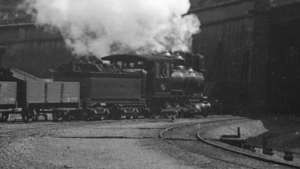railroad.wikisort.org - TrainThe NZR T class was a class of steam locomotive used in New Zealand; of the "Consolidation" type, popular in North America, especially with the narrow gauge Denver and Rio Grande Western Railroad.
| NZR T class |
|---|
 Goods train with T class locomotive leaving Lyttelton, ca. 1904 |
| Type and origin |
|---|
| Power type | Steam |
|---|
| Builder | Baldwin Locomotive Works, United States |
|---|
| Serial number | 4660–4661, 4664-4667 |
|---|
| Build date | 1879 |
|---|
| Total produced | 6 |
|---|
|
| Specifications |
|---|
Configuration:
| |
|---|
| • Whyte | 2-8-0 |
|---|
| • UIC | 1′D |
|---|
| Gauge | 3 ft 6 in (1,067 mm) |
|---|
| Driver dia. | 36 in (914 mm) |
|---|
| Length | 44 ft 10 in (13.67 m) |
|---|
| Adhesive weight | 23.0 long tons (23.4 t; 25.8 short tons)
24.7 long tons (25.1 t; 27.7 short tons) (reboilered) |
|---|
| Loco weight | 26.2 long tons (26.6 t; 29.3 short tons) |
|---|
| Tender weight | 16.0 long tons (16.3 t; 17.9 short tons) |
|---|
| Fuel type | Coal |
|---|
| Fuel capacity | 2.1 long tons (2.1 t; 2.4 short tons) |
|---|
| Water cap. | 1,300 imp gal (5,900 l; 1,600 US gal) |
|---|
Firebox:
• Firegrate area | 15.7 sq ft (1.46 m2) |
|---|
| Boiler pressure | 130 psi (896 kPa)
160 psi (1,103 kPa) (reboilered) |
|---|
| Heating surface | 812 sq ft (75.4 m2)
920 sq ft (85 m2) (reboilered) |
|---|
| Superheater | None |
|---|
| Cylinders | Two, outside |
|---|
| Cylinder size | 15 in × 18 in (381 mm × 457 mm) |
|---|
|
| Performance figures |
|---|
| Maximum speed | 18 mph (29 km/h) |
|---|
| Tractive effort | 11,700 lbf (52.04 kN)
14,300 lbf (63.61 kN) (reboilered) |
|---|
|
| Career |
|---|
| Operators | New Zealand Railways |
|---|
| Numbers | 101–106 |
|---|
| Locale | All of New Zealand |
|---|
| First run | 1880 |
|---|
| Disposition | All scrapped |
|---|
|
History
The Baldwin and Rogers locomotives reflected the styling adopted in the 1870s by American builders with elements from the Renaissance Revival and Neo-Baroque architectural styles, and with Islamic e.g. Moorish (from Alhambra) influences. Bold colours and painted decorations were used. Many Baldwin locomotives were in Olive Green ground colour, although the Baldwin N and O classes of the 1880s had Tuscan Red ground colour.[2]
In service
Because of its small diameter driving wheels, the T class was typically limited to a speed of 29 km/h (18 mph).
Withdrawal and disposal
The first T class locomotive was withdrawn in 1922, with the last example withdrawn in 1924. Some managed to survive long enough to be dumped or have components dumped when the NZR started dumping locomotives for embankment protection in 1926.
References
Citations
- New Zealand's Early American Locomotives: The Design, Art and Architecture of the K, T and O Class Locomotives Part 2 by David Fletcher: "New Zealand Railfan", March 2015 pages 33-49: Volume 21 No 2
Bibliography
- Millar, Sean (2011). The NZR Steam Locomotive. Wellington: New Zealand Railway and Locomotive Society. ISBN 978-0-908573-89-9.
- Palmer, A. N.; Stewart, W. W. (1965). Cavalcade of New Zealand Locomotives. Wellington: A H. & A W. Reed. ISBN 978-0-207-94500-7.
- Stewart, W. W. (1974). When Steam was King. Wellington: A. H. & A. W. Reed Ltd. ISBN 978-0-589-00382-1.
Rail vehicles of New Zealand |
|---|
| Diesel locomotives |
- DA (inc. DAA, DAR)
- DB (inc. DBR)
- DC (inc. DCP)
- DE
- DF (English Electric)
- DF (General Motors) inc. DFT, DFB, DFM
- DG (inc. DH of 1956)
- DH of 1978
- DI
- DJ
- DL
- DM (on order)
- DQ and QR
- DS
- DSA
- DSB
- DSC
- DSG
- DSJ
- DX (inc. DXB, DXC, DXR)
- TR
|
|---|
| Diesel Multiple Units |
- ADK/ADB class diesel multiple unit
- ADL/ADC class diesel multiple unit
|
|---|
| Electric locomotives | | 1500 V DC |
- EA (later EO of 1968)
- EC
- ED
- EO of 1923
- EW
|
|---|
| 25 kV AC | |
|---|
| Battery | |
|---|
|
|---|
| Electric Multiple Units | | 1500 V DC (Wellington) |
- "English Electric" DM (inc. D trailers)
- "Ganz Mavag" EM (inc. ET trailers)
- "Matangi" FP (inc. FT trailers)
|
|---|
| 25 kV AC (Auckland) | |
|---|
|
|---|
| Railcars | | RM class |
- 88 seater (also known as Fiats or twinsets)
- Clayton steam railcar
- Edison battery-electric railcar
- Red Terror railcar
- Midland railcar
- Leyland experimental petrol railcar
- McEwan Pratt petrol railcar
- Model T Ford railcar
- Sentinel-Cammell steam railcar
- Silver Fern railcar
- Standard railcar
- Thomas Transmission railcar
- Vulcan railcar
- Wairarapa railcar
- Westinghouse railcar
|
|---|
| Others |
- A 88 Buckhurst petrol carriage
|
|---|
|
|---|
| Steam locomotives | |
|---|
| Locomotive hauled carriages |
- 50-foot carriage
- 56-foot carriage
- AC class (Grassgrubs)
- ex-British Rail Mark 2 carriage
- AK carriage
- FM class guards van
- SX carriages
|
|---|
- Locomotives of New Zealand
- Rail transport in New Zealand
- Railway preservation in New Zealand.
|
Текст в блоке "Читать" взят с сайта "Википедия" и доступен по лицензии Creative Commons Attribution-ShareAlike; в отдельных случаях могут действовать дополнительные условия.
Другой контент может иметь иную лицензию. Перед использованием материалов сайта WikiSort.org внимательно изучите правила лицензирования конкретных элементов наполнения сайта.
2019-2025
WikiSort.org - проект по пересортировке и дополнению контента Википедии
